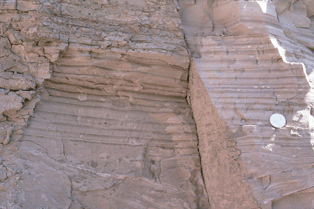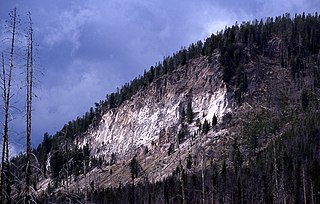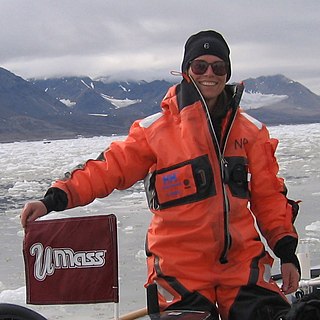Related Research Articles
Great Basalt Wall is a national park in Queensland, Australia, 1124 km northwest of Brisbane. This national park protects 35,200 ha of land containing the Great Basalt Wall, a geological formation of the Toomba flow. The Toomba volcano erupted approximately 20,000 years ago, covered 670 square kilometres, and flowed for 120 km. It is one of the most recent volcanic eruptions in Queensland. Due to the viscous nature of the rocky lava flows the park is not accessible to the public.

Geochronology is the science of determining the age of rocks, fossils, and sediments using signatures inherent in the rocks themselves. Absolute geochronology can be accomplished through radioactive isotopes, whereas relative geochronology is provided by tools such as paleomagnetism and stable isotope ratios. By combining multiple geochronological indicators the precision of the recovered age can be improved.

A loess is a clastic, predominantly silt-sized sediment that is formed by the accumulation of wind-blown dust. Ten percent of Earth's land area is covered by loesses or similar deposits.

A varve is an annual layer of sediment or sedimentary rock.
Before Present (BP) years, also known as "time before present" or "years before present (YBP)", is a time scale used mainly in archaeology, geology and other scientific disciplines to specify when events occurred relative to the origin of practical radiocarbon dating in the 1950s. Because the "present" time changes, standard practice is to use 1 January 1950 as the commencement date (epoch) of the age scale. The abbreviation "BP" has been interpreted retrospectively as "Before Physics", which refers to the time before nuclear weapons testing artificially altered the proportion of the carbon isotopes in the atmosphere, which scientists must now account for.

In archaeology, palaeontology, and geomorphology, lichenometry is a geomorphic method of geochronologic dating that uses lichen growth to determine the age of exposed rock, based on a presumed specific rate of increase in radial size over time. Measuring the diameter of the largest lichen of a species on a rock surface can therefore be used to determine the length of time the rock has been exposed. Lichen can be preserved on old rock faces for up to 10,000 years, providing the maximum age limit of the technique, though it is most accurate when applied to surfaces that have been exposed for less than 1,000 years. Lichenometry is especially useful for dating surfaces less than 500 years old, as radiocarbon dating techniques are less accurate over this period. The lichens most commonly used for lichenometry are those of the genera Rhizocarpon and Xanthoria. The measured growth rates of R. geographicum tends to fall within the range of 0.9–0.3 millimeter per year, depending on several factors, including the size of the lichen patch.

The Lava Creek Tuff is a voluminous sheet of ash-flow tuff located in Wyoming, Montana and Idaho, United States. It was created during the Lava Creek eruption around 630,000 years ago, which led to the formation of the Yellowstone Caldera. This eruption is considered the climactic event of Yellowstone's third volcanic cycle. The Lava Creek Tuff covers an area of more than 7,500 km2 (2,900 sq mi) centered around the caldera and has an estimated magma volume of 1,000 km3 (240 cu mi).
Absolute dating is the process of determining an age on a specified chronology in archaeology and geology. Some scientists prefer the terms chronometric or calendar dating, as use of the word "absolute" implies an unwarranted certainty of accuracy. Absolute dating provides a numerical age or range, in contrast with relative dating, which places events in order without any measure of the age between events.
Amino acid dating is a dating technique used to estimate the age of a specimen in paleobiology, molecular paleontology, archaeology, forensic science, taphonomy, sedimentary geology and other fields. This technique relates changes in amino acid molecules to the time elapsed since they were formed.

Reclus, also written as Reclús, is a volcano located in the Southern Patagonian Ice Field, Chile. Part of the Austral Volcanic Zone of the Andes, its summit rises 1,000 metres (3,300 ft) above sea level and is capped by a crater about 1 kilometre (0.62 mi) wide. Close to the volcano lies the Amalia Glacier, which is actively eroding Reclus.
In radiometric dating, closure temperature or blocking temperature refers to the temperature of a system, such as a mineral, at the time given by its radiometric date. In physical terms, the closure temperature is the temperature at which a system has cooled so that there is no longer any significant diffusion of the parent or daughter isotopes out of the system and into the external environment. The concept's initial mathematical formulation was presented in a seminal paper by Martin H. Dodson, "Closure temperature in cooling geochronological and petrological systems" in the journal Contributions to Mineralogy and Petrology, 1973, with refinements to a usable experimental formulation by other scientists in later years. This temperature varies broadly among different minerals and also differs depending on the parent and daughter atoms being considered. It is specific to a particular material and isotopic system.
Surface exposure dating is a collection of geochronological techniques for estimating the length of time that a rock has been exposed at or near Earth's surface. Surface exposure dating is used to date glacial advances and retreats, erosion history, lava flows, meteorite impacts, rock slides, fault scarps, cave development, and other geological events. It is most useful for rocks which have been exposed for between 103 and 106 years.
Lynch's Crater formed about 230,000 years ago during an explosive volcanic eruption, creating a maar on the eastern edge of the Atherton Tableland in Queensland, Australia. Located at an altitude of about 760 m, the crater is about 80 m deep and has been heavily worn by erosion. Following its formation, a crater lake formed in the depression that was gradually filled in with deposits, so that the surface is now an average of 45 m beneath the rim. The present day interior is filled with swampy ground that is maintained by a stream flowing in from the eastern side. This water exits the crater to form a tributary of the North Johnstone River. The mean annual rainfall at this site is 2,500 mm.
Electron spin resonance dating, or ESR dating, is a technique used to date materials which radiocarbon dating cannot, including minerals, biological materials, archaeological materials and food. Electron spin resonance dating was first introduced to the science community in 1975, when Japanese nuclear physicist Motoji Ikeya dated a speleothem in Akiyoshi Cave, Japan. ESR dating measures the amount of unpaired electrons in crystalline structures that were previously exposed to natural radiation. The age of a substance can be determined by measuring the dosage of radiation since the time of its formation.
Chronological dating, or simply dating, is the process of attributing to an object or event a date in the past, allowing such object or event to be located in a previously established chronology. This usually requires what is commonly known as a "dating method". Several dating methods exist, depending on different criteria and techniques, and some very well known examples of disciplines using such techniques are, for example, history, archaeology, geology, paleontology, astronomy and even forensic science, since in the latter it is sometimes necessary to investigate the moment in the past during which the death of a cadaver occurred. These methods are typically identified as absolute, which involves a specified date or date range, or relative, which refers to dating which places artifacts or events on a timeline relative to other events and/or artifacts. Other markers can help place an artifact or event in a chronology, such as nearby writings and stratigraphic markers.

Monte Burney is a volcano in southern Chile, part of its Austral Volcanic Zone which consists of six volcanoes with activity during the Quaternary. This volcanism is linked to the subduction of the Antarctic Plate beneath the South America Plate and the Scotia Plate.

Optically stimulated luminescence (OSL) thermochronometry is a dating method used to determine the time since quartz and/or feldspar began to store charge as it cools through the effective closure temperature. The closure temperature for quartz and Na-rich K-feldspar is 30-35 °C and 25 °C respectively. When quartz and feldspar are beneath the earth, they are hot. They cool when any geological process e.g. focused erosion causes their exhumation to the earth surface. As they cool, they trap electron charges originating from within the crystal lattice. These charges are accommodated within crystallographic defects or vacancies in their crystal lattices as the mineral cools below the closure temperature.

Julie Brigham-Grette is a glacial geologist and a professor in the Department of Geosciences at the University of Massachusetts Amherst where she co-directs the Joseph Hartshorn Quaternary Laboratory. Her research expertise is in glacial geology and paleoclimatology; she has made important contributions to Arctic marine and terrestrial paleoclimate records of late Cenozoic to recent, the evolution of the Arctic climate, especially in the Beringia/Bering Strait region, and was a leader of the international Lake El’gygytgyn Drilling Project in northeastern Russia.
Kinrara is a volcano in Queensland, Australia. It is one of the youngest volcanoes in Australia, and erupted 7,000 years ago.
D-Amino acids are amino acids where the stereogenic carbon alpha to the amino group has the D-configuration. For most naturally-occurring amino acids, this carbon has the L-configuration. D-Amino acids are occasionally found in nature as residues in proteins. They are formed from ribosomally-derived D-amino acid residues.
References
- 1 2 3 Liljegren, Ronnie. "kvartärgeologi". Nationalencyclopedin (in Swedish). Cydonia Development. Retrieved May 15, 2015.
- 1 2 "Quaternary geology". Norwegian Geological Survey . February 25, 2015. Retrieved May 15, 2015.
- ↑ Armstrong, R. A.; Bradwell, T. (2015-06-01). "'Growth rings' in crustose lichens: Comparison with directly measured growth rates and implications for lichenometry". Quaternary Geochronology. 28: 88–95. doi:10.1016/j.quageo.2015.04.003. ISSN 1871-1014.
- ↑ Koch, Johannes (2009-04-01). "Improving age estimates for late Holocene glacial landforms using dendrochronology – Some examples from Garibaldi Provincial Park, British Columbia". Quaternary Geochronology. 4 (2): 130–139. doi:10.1016/j.quageo.2008.11.002. ISSN 1871-1014.
- ↑ Penkman, Kirsty; Kaufman, Darrell (2013-04-01). "Amino acid geochronology: Recent perspectives". Quaternary Geochronology. Amino Acid Racemization. 16: 1–2. doi:10.1016/j.quageo.2012.12.007. ISSN 1871-1014.
- ↑ Noller, Jay Stratton; Sowers, Janet M.; Colman, Steven M.; Pierce, Kenneth L. (2013). "Introduction to Quaternary Geochronology". Quaternary Geochronology. AGU Reference Shelf. pp. 1–10. doi:10.1029/RF004p0001. ISBN 9781118668481.